Efficiency of Laser-Shaped Photovoltaic Cells
Abstract
1. Introduction
2. Materials and Methods
2.1. Laser Shaping of Photovoltaic Cells
2.2. Microscopic Research (SEM)
3. Experimental Results
4. Conclusions
Author Contributions
Funding
Conflicts of Interest
References
- IEA—International Energy Agency. 2014. Available online: http://www.iea.org/publications/freepublications/publication/TechnologyRoadmapSolarPhotovoltaicEnergy_2014edition.pdf (accessed on 15 May 2020).
- Goetzberger, A.; Hebling, C. Photovoltaic materials, past, present, future. Sol. Energy Mater. Sol. Cells 2000, 62, 1–19. [Google Scholar] [CrossRef]
- Drzymała, A.J.; Korzeniewska, E. Profitability of solar photovoltaic investment in the light of the new act on renewable energy in Poland. Prz. Elektrotechniczny 2020, 96, 210–213. [Google Scholar]
- Nęcka, K.; Lis, S.; Dróżdż, T.; Oziembłowski, M.; Kiełbasa, P.; Tomasik, M.; Ostafin, M.; Nawara, P. Characteristics of photovoltaic power unit under variable metheorological conditions. Prz. Elektrotechniczny 2016, 12, 105–108. [Google Scholar]
- Tomasik, M.; Knaga, J.; Lis, S.; Gliniak, M. Analysis of the Effectiveness of the Prototype PV Tracking System. In Proceedings of the 2018 Applications of Electromagnetics in Modern Techniques and Medicine, PTZE 2018, Raclawice, Poland, 9–12 September 2018; IEEE: Piscataway, NJ, USA, 2018; Volume 8503095, pp. 101–104. [Google Scholar]
- Korzeniewska, E.; Drzymała, A. Photovoltaic power plants—Technical and economic aspects. Prz. Elektrotechniczny 2013, 12, 324–327. [Google Scholar]
- Tapakis, R.; Charalambides, A.G. Equipment and methodologies for cloud detection and classification: A review. Sol. Energy 2013, 95, 392–430. [Google Scholar] [CrossRef]
- Eiffert, P.; Kiss, G.J. Building-Integrated Photovoltaic Designs for Commercial and Institutional Structures A Sourcebook for Architects. Available online: https://www.nrel.gov/docs/fy00osti/25272.pdf (accessed on 15 May 2020).
- Yankodesign. Available online: http://www.yankodesign.com (accessed on 15 May 2020).
- Dobrzański, L.A.; Drygała, A.; Macek, M.; Giedroć, M. Monocrystalline silicon solar cells applied in photovoltaic system. J. Achiev. Mater. Manuf. Eng. 2012, 1, 7–13. [Google Scholar]
- Zhao, Z.; Li, P.; Wei, Y.; Lu, C.; Tan, X.; Liu, A. 17.3% efficient black silicon solar cell without dielectric antireflection coating. Sol. Energy 2014, 110, 714–719. [Google Scholar] [CrossRef]
- Parida, B.; Iniyanb, S.; Goic, R. A review of solar photovoltaic technologies. Renew. Sustain. Energy Rev. 2011, 15, 1625–1636. [Google Scholar] [CrossRef]
- Green, M.A.; Hishikawa, Y.; Warta, W.; Dunlop, E.D.; Levi, D.H.; Hohl-Ebinger, J.; Ho-Baillie, A. Solar cell efficiency tables (version 50). Prog. Photovolt. Res. Appl. 2017, 25, 668–676. [Google Scholar] [CrossRef]
- Li, Y.; Ji, C.; Qu, Y.; Huang, X.; Hou, S.; Li, C.-Z.; Liao, L.-S.; Guo, L.J.; Forrest, S.R. High Efficiency Semi-Transparent Organic Photovoltaics. In Proceedings of the IEEE 46th Photovoltaic Specialists Conference (PVSC), Chicago, IL, USA, 16–21 June 2019; pp. 98–100. [Google Scholar]
- Hatamvand, M.; Kamrani, E.; Lira-Cantú, M.; Madsen, M.; Patil, B.R.; Vivo, P.; Mehmood, M.S.; Numan, A.; Ahmed, I.; Zhan, Y. Recent advances in fiber-shaped and planar-shaped textile solar cells. Nano Energy 2020, 71, 104609. [Google Scholar] [CrossRef]
- Dharmadasa, I.M.; Roberts, J.S.; Hill, G. Third generation multilayer graded bandgap solar cells for achieving high conversion efficiencies-II. Sol. Energy Mater. Sol. Cells 2005, 88, 413–422. [Google Scholar] [CrossRef]
- Li, H.; Wang, S. Coordinated robust optimal design of building envelope and energy systems for zero/low energy buildings considering uncertainties. Appl. Energy 2020, 265, 114779. [Google Scholar] [CrossRef]
- Kasprzyk, L.; Bednarek, K. Speeding up of electromagnetic and optimization calculations by the use of the parallel algorithms. Prz. Elektrotechniczny 2009, 12, 65–68. [Google Scholar]
- Kasprzyk, L. Optimization of Lighting Systems with the use of the Parallelized Genetic Algorithm on Multi-Core Processors using the NET Technology. Prz. Elektrotechniczny 2012, 88, 131–133. [Google Scholar]
- Rauf, I.A.; Rezai, P. A review of materials selection for optimized efficiency in quantum dot sensitized solar cells: A simplified approach to reviewing literature data. Renew. Sustain. Energy Rev. 2017, 73, 408–422. [Google Scholar] [CrossRef]
- Huang, Z.; Cai, C.; Kuai, L.; Li, T.; Huttula, M.; Cao, W. Leaf-structure patterning for antireflective and self-cleaning surfaces on Si-based solar cells. Sol. Energy 2018, 159, 733–741. [Google Scholar] [CrossRef]
- De La Mora, M.; Amelines-Sarria, O.; Monroy, B.; Hernández-Pérez, C.; Lugo, J. Materials for downconversion in solar cells: Perspectives and challenges. Sol. Energy Mater. Sol. Cells 2017, 165, 59–71. [Google Scholar] [CrossRef]
- Prasad, M.R.; Kadam, V.; Joo, O.-S.; Pathan, H.M. Improving the photovoltaic parameters in Quantum dot sensitized solar cells through employment of chemically deposited compact titania blocking layer. Mater. Chem. Phys. 2017, 194, 165–171. [Google Scholar] [CrossRef]
- Gečys, P.; Markauskas, E.; Žemaitis, A.; Račiukaitis, G. Variation of P2 series interconnects electrical conductivity in the CIGS solar cells by picosecond laser-induced modification. Sol. Energy 2016, 132, 493–502. [Google Scholar] [CrossRef]
- Westin, P.-O.; Wätjen, J.T.; Zimmermann, U.; Edoff, M. Microanalysis of laser micro-welded interconnections in CIGS PV modules. Sol. Energy Mater. Sol. Cells 2012, 98, 172–178. [Google Scholar] [CrossRef]
- Pawlak, R.; Rosowski, A.; Tomczyk, M.; Walczak, M. Laser microscale technologies: Modeling assisted processes. Proc. SPIE 2013, 8703, 87030N. [Google Scholar]
- Pawlak, R.; Tomczyk, M.; Walczak, M.; Mizeraczyk, J.; Tanski, M.; Garasz, K. Selected problems in IR and UV laser micromachining of Si and GaAs in submillimeter scale. Microelectron. Eng. 2016, 151, 47–52. [Google Scholar] [CrossRef]
- Gečys, P.; Markauskas, E.; Gedvilas, M.; Račiukaitis, G.; Repins, I.; Beall, C. Ultrashort pulsed laser induced material lift-off processing of CZTSe thin-film solar cells. Sol. Energy 2014, 102, 82–90. [Google Scholar] [CrossRef]
- Hermann, J.; Benfarah, M.; Bruneau, S.; Axente, E.; Coustillier, G.; Itina, T.E.; Guillemoles, J.-F.; Alloncle, P. Comparative investigation of solar cell thin film processing using nanosecond and femtosecond lasers. J. Phys. D Appl. Phys. 2006, 39, 453. [Google Scholar] [CrossRef]
- Compaan, A.D.; Matulionis, I.; Nakade, S. Laser scribing of polycrystalline thin films. Opt. Lasers Eng. 2000, 34, 15–45. [Google Scholar] [CrossRef]
- Marie, F. Lasers Change the Shape of the Photovoltaics Industry. Photonics Spectra 2012, 46, 61–63. [Google Scholar]
- Abbott, M.D.; Trupke, T.; Hartmann, H.P.; Gupta, R.; Breitenstein, O. Laser isolation of shunted regions in industrial solar cells. Prog. Photovolt. Res. Appl. 2007, 15, 613–620. [Google Scholar] [CrossRef]
- Bovatsek, J.; Tamhankar, A.; Patel, R.; Bulgakova, N.; Bonse, J. Thin film removal mechanisms in ns-laser processing of photovoltaic materials. Thin Solid Film 2010, 518, 2897–2904. [Google Scholar] [CrossRef]
- Johnston, S.; Sulas, D.B.; Kroeger, G.F. Laser cutting and micromachining for localized and targeted solar cell characterization. In Proceedings of the IEEE 46th Photovoltaic Specialists Conference (PVSC), Chicago, IL, USA, 16–21 June 2019; pp. 2753–2757. [Google Scholar] [CrossRef]
- Markauskas, E.; Gečys, P.; Žemaitis, A.; Gedvilas, M.; Račiukaitis, G. Validation of monolithic interconnection conductivity in laser scribed CIGS thin-film solar cells. Sol. Energy 2015, 120, 35–43. [Google Scholar] [CrossRef]
- Rymarczyk, T. Electrical Capacitance Tomography and Optical Detection in Quality Control System. Prz. Elektrotechniczny 2017, 12, 211–214. [Google Scholar]
- Rymarczyk, T.; Tchorzewski, P.; Adamkiewicz, P.; Duda, K.; Szumowski, J.; Sikora, J. Practical Implementation of Electrical Tomography in a Distributed System to Examine the Condition of Objects. IEEE Sens. J. 2017, 17, 8166–8186. [Google Scholar] [CrossRef]
- Gliścińska, E.; Sankowski, D.; Krucińska, I.; Goclawski, J.; Michalak, M.; Rowinska, Z.; Sekulska-Nalewajko, J. Optical coherence tomography image analysis of polymer surface layers in sound-absorbing fibrous composite materials. Polym. Test. 2017, 63, 194–203. [Google Scholar] [CrossRef]
- Pawlak, R.; Kawczyński, R.; Korzeniewska, E.; Lebioda, M.; Rosowski, A.; Rymaszewski, J.; Sibiński, M.; Tomczyk, M.; Walczak, M. Photovoltaic cells of unconventional shapes. Prz. Elektrotechniczny 2013, 7, 288–292. [Google Scholar]
- Znajdek, K.; Szczecińska, N.; Sibiński, M.; Czarnecki, P. Energy converting layers for thin-film flexible photovoltaic structures. Open Phys. 2018, 16, 820–825. [Google Scholar] [CrossRef]

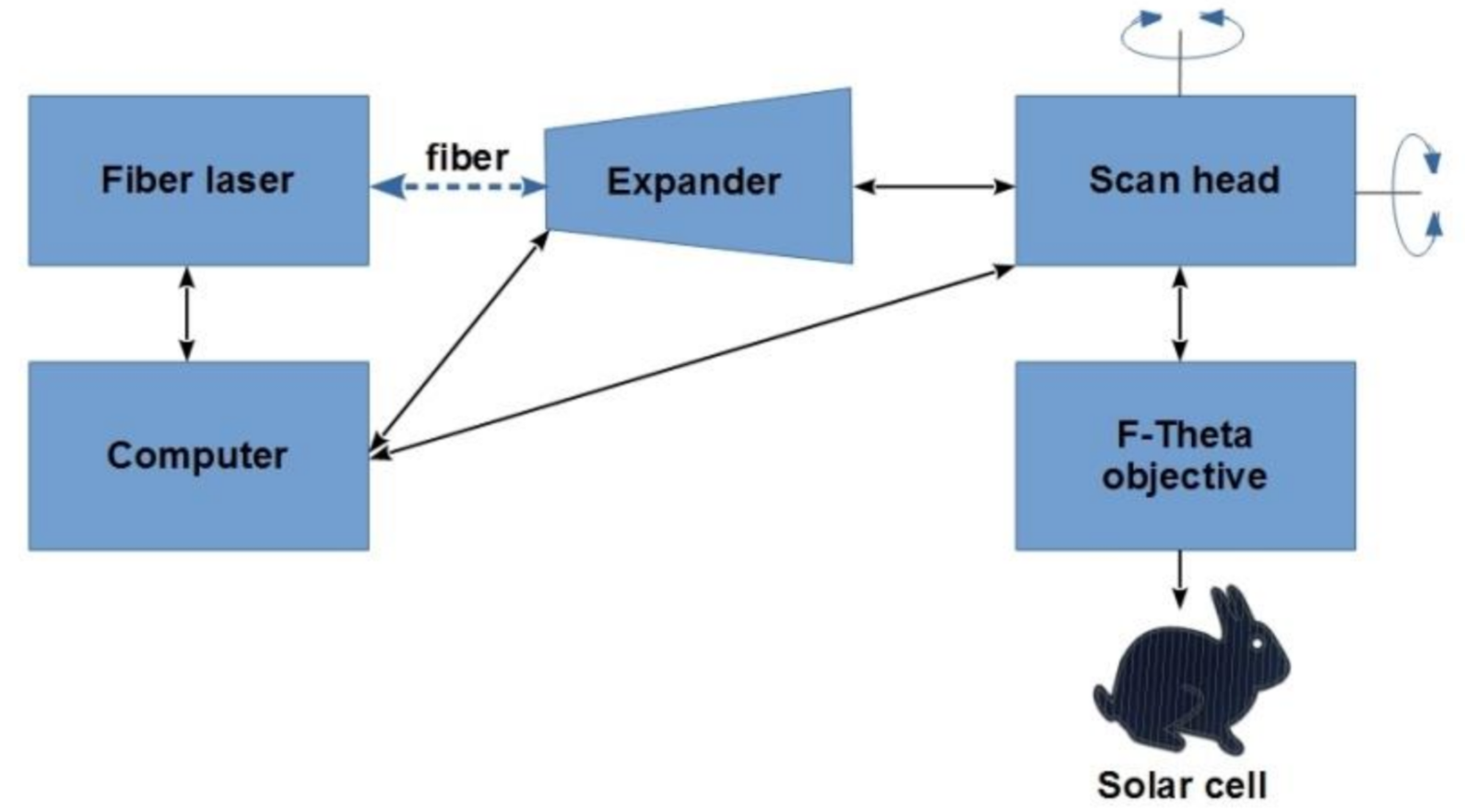
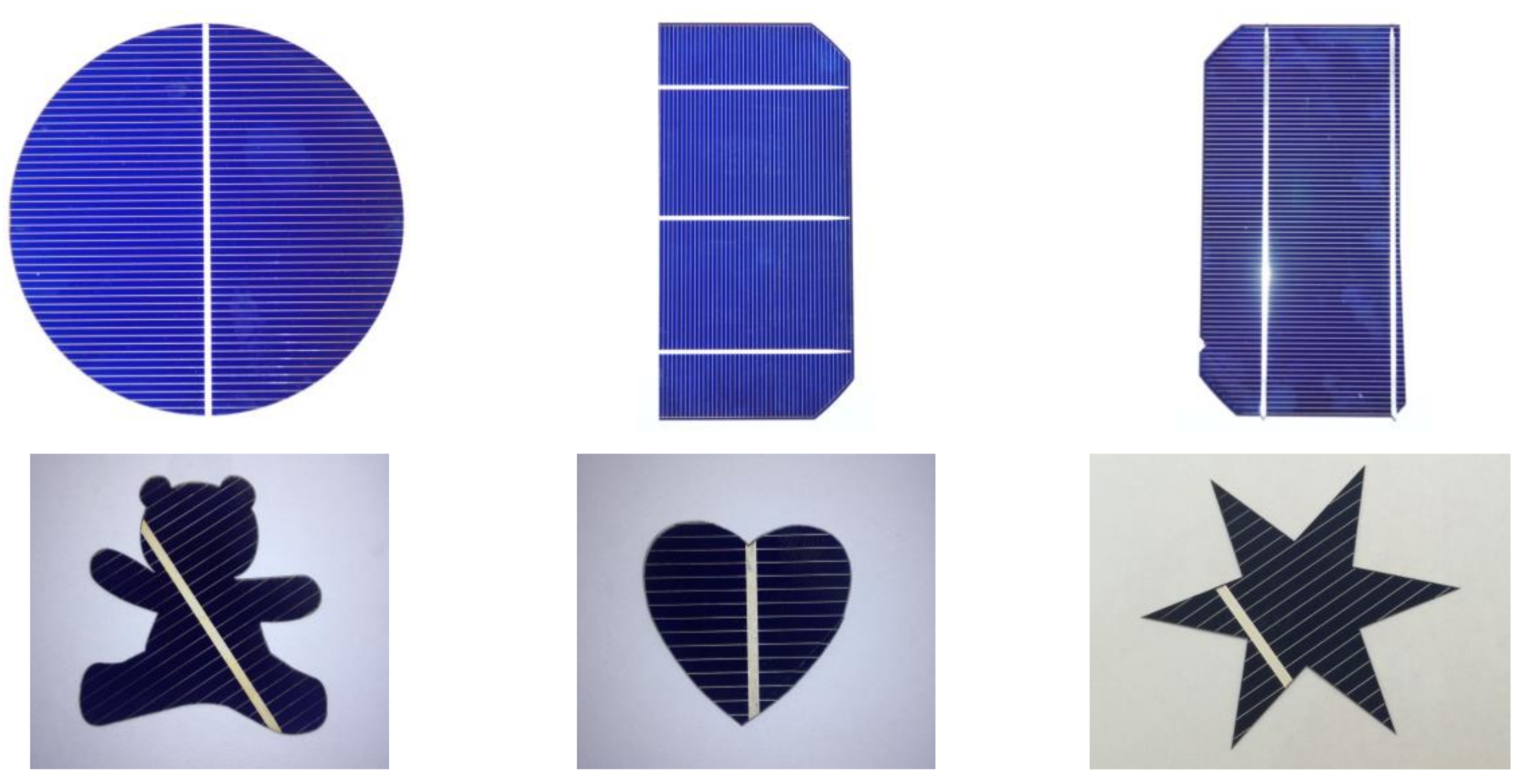
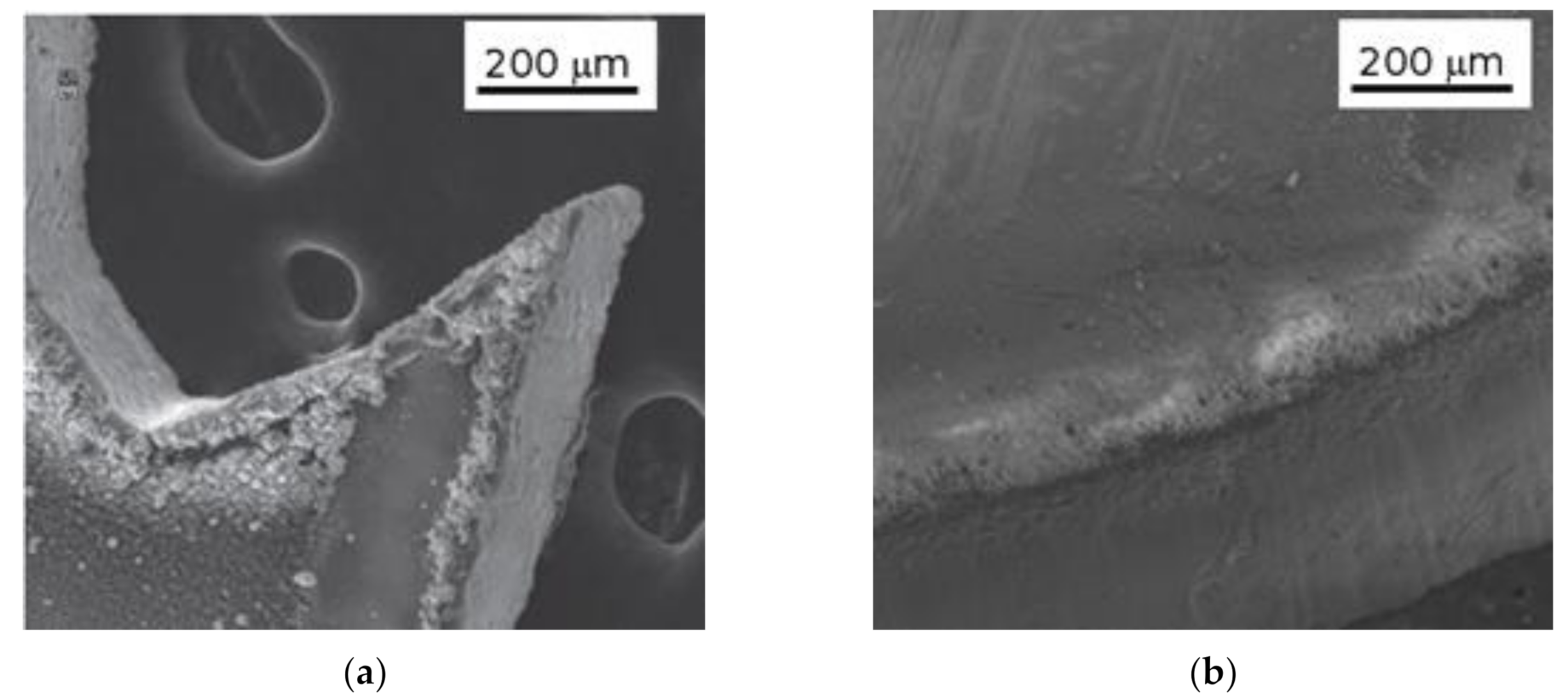
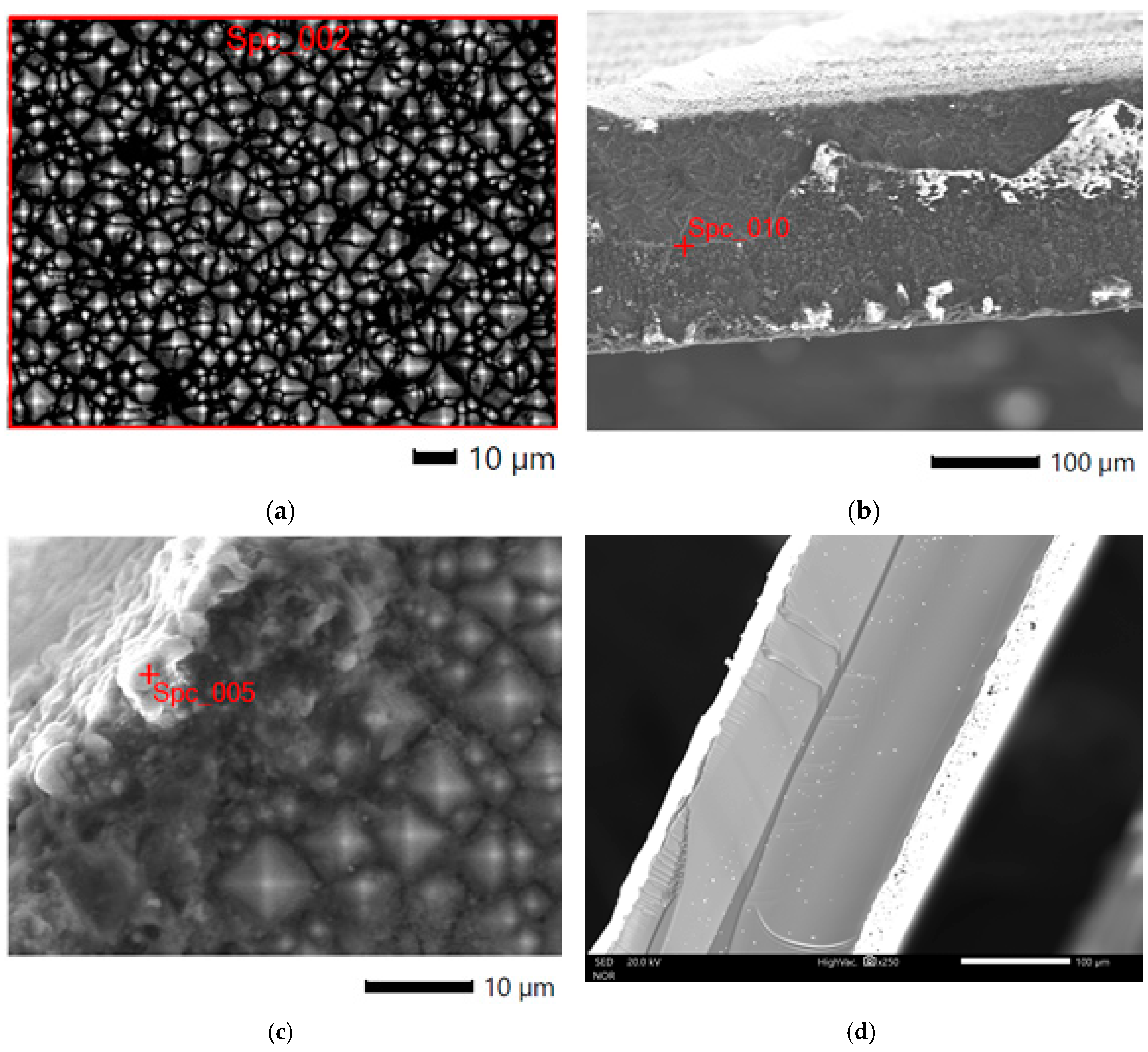
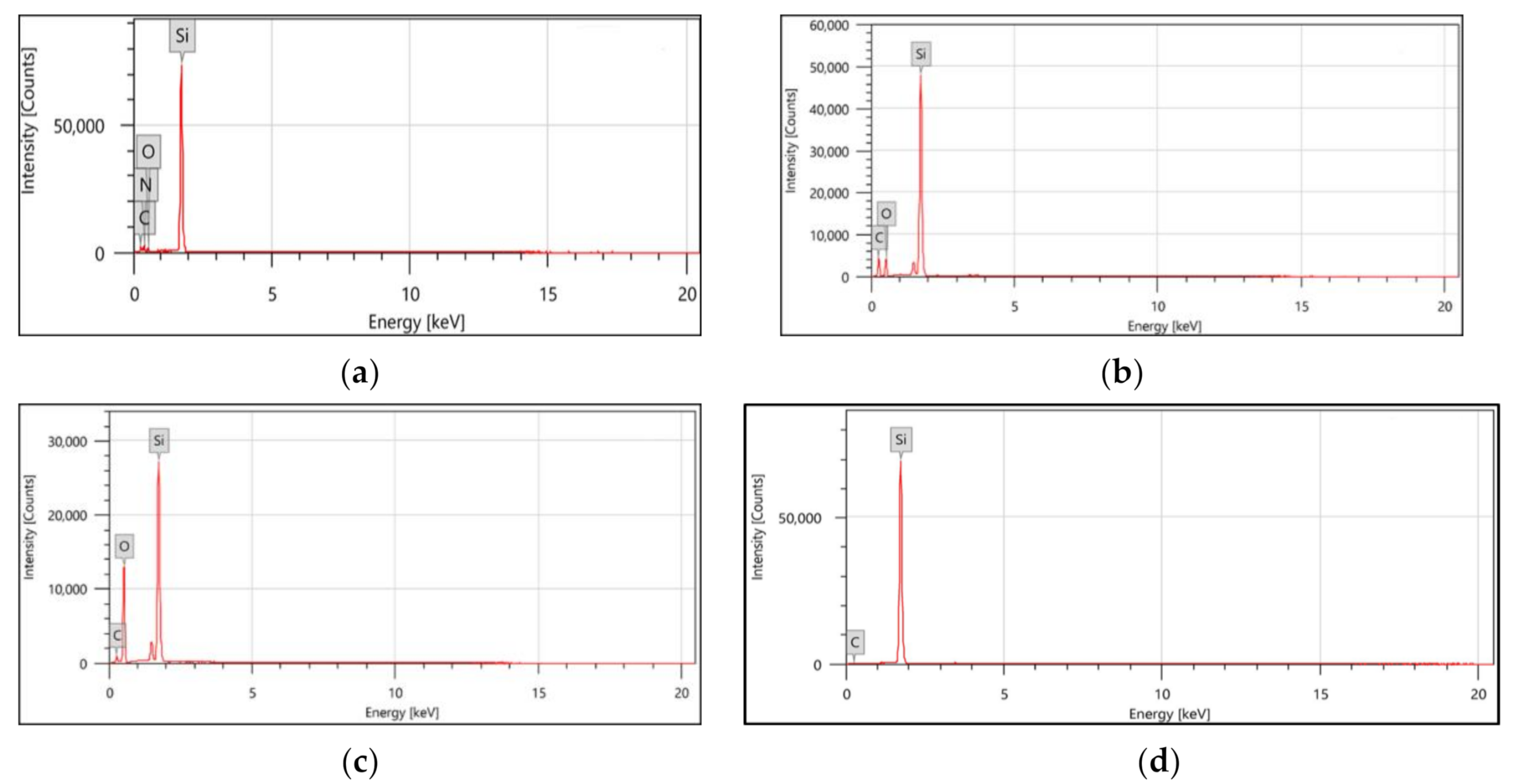

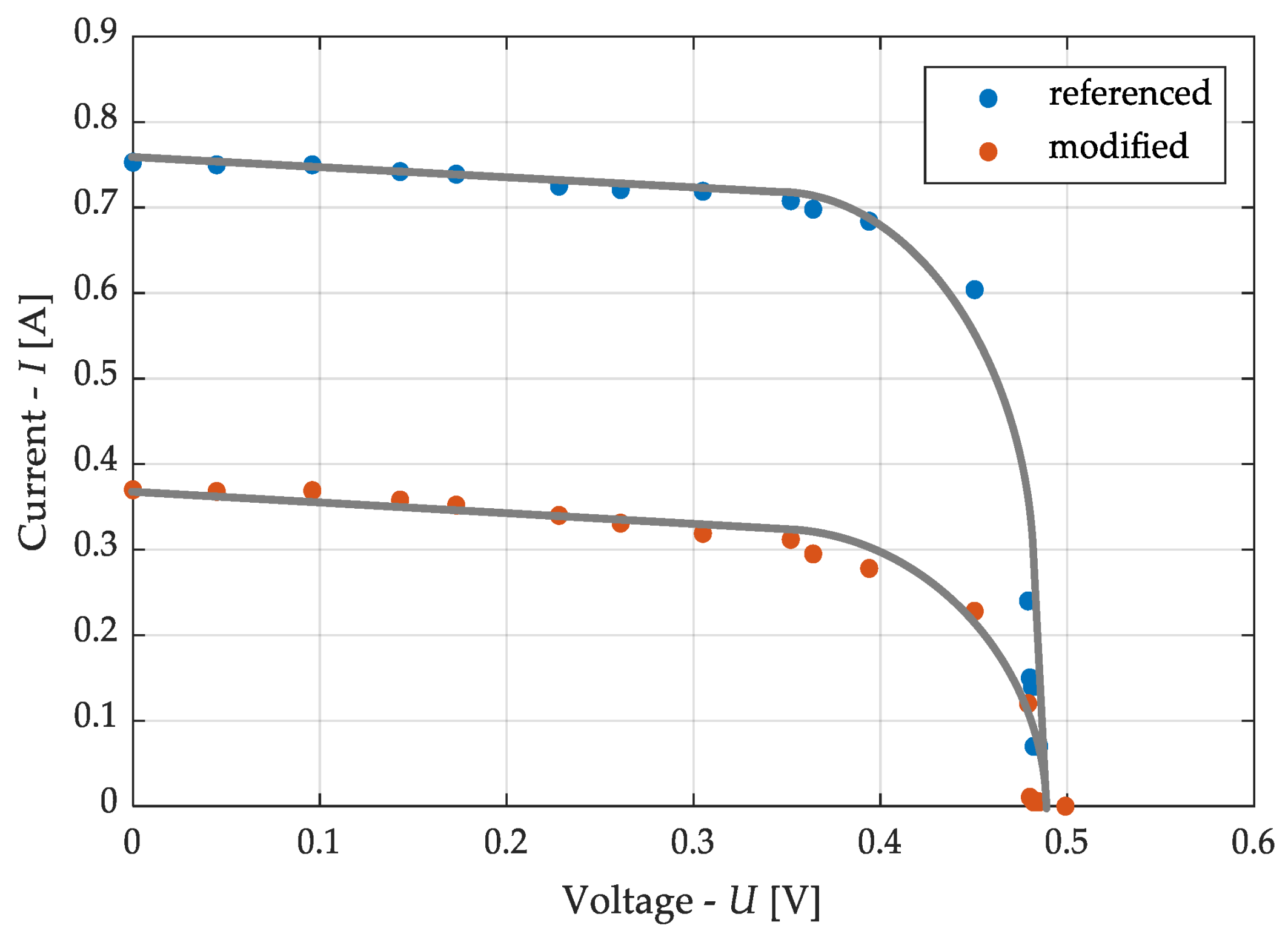
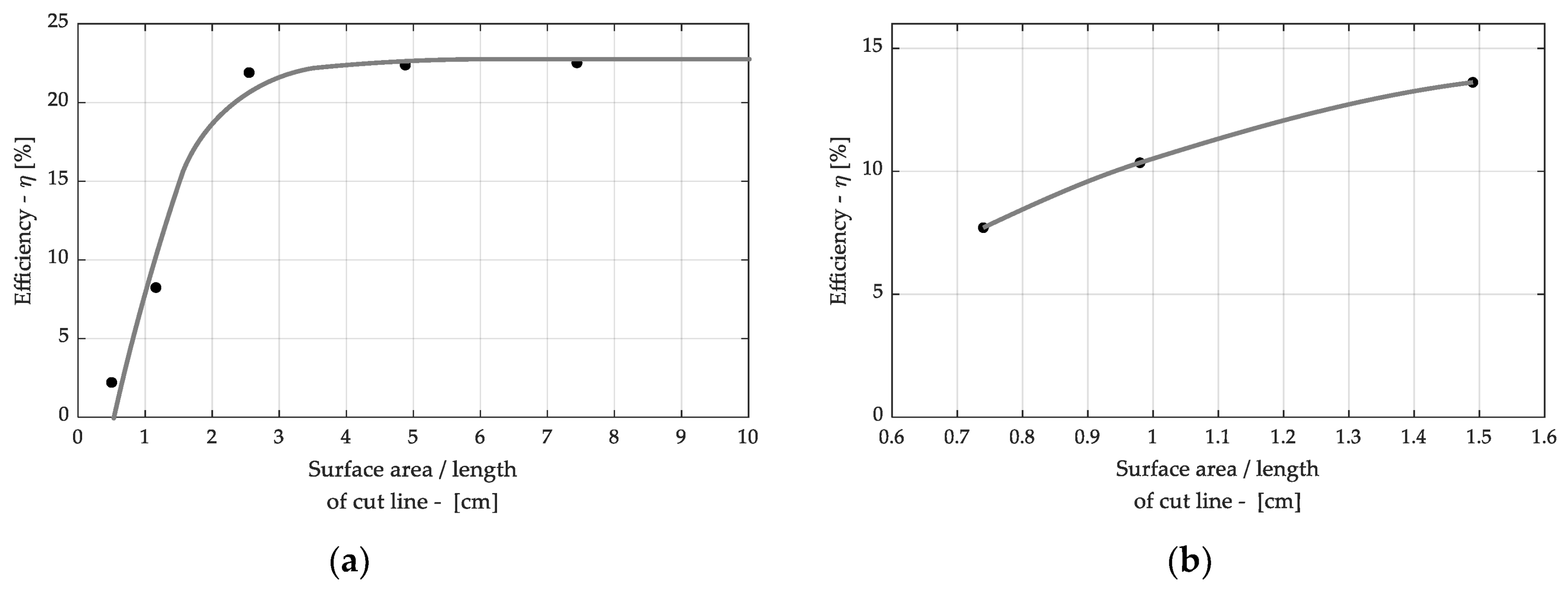
| Laser SPI redEnergy G3 SM 20W | |
|---|---|
| Wave length [nm] | 1062 |
| Average power of the beam [W] | 20 |
| Duration of the pulse [ns] | 15–220 |
| Pulse energy [mJ] | ≤0.55 |
| Frequency of repetition [kHz] | 35–290 |
| Quality of beam [M2] | <1.3 |
| Skaner Xtreme (Nutfield Techn. Inc.) | |
| F-theta lens [mm] | 100–160 |
| Maximum scanning speed [mm/s] | 6000 |
| Working area [mm] | 70 × 70; 120 × 120 |
| Software | SB-1P Waverunner |
| Laser-Beam Type | Single Mode |
|---|---|
| Wavelength of the laser | 1062 nm |
| Number of repetitions | 30/40 for thick photovoltaic cells |
| Scan speed | 200 mm/s |
| Average power of the beam | 15–20 W |
| Frequency of impulse repetition | 35 kHz |
| Pulse duration | 220 ns |
| Expander | 3 |
| M2 multimode laser-beam quality parameter | 1.3 |
| Without Modification | On the Cutting Edge | On the Surface Near the Cut Line | On the Surface of the Fracture | |||||
|---|---|---|---|---|---|---|---|---|
| Element | Mass [%] | Atom [%] | Mass [%] | Atom [%] | Mass [%] | Atom [%] | Mass [%] | Atom [%] |
| C | 19.73 ± 0.10 | 31.77 ± 0.17 | 40.92 ± 0.13 | 57.90 ± 0.19 | 12.39 ± 0.09 | 19.34 ± 0.15 | 8.91 ± 0.17 | 18.61 ± 0.36 |
| O | 3.28 ± 0.04 | 3.97 ± 0.05 | 13.86 ± 0.08 | 14.73 ± 0.09 | 43.89 ± 0.15 | 51.46 ± 0.17 | 0.00 | 0.00 |
| Si | 60.77 ± 0.11 | 41.86 ± 0.08 | 45.22 ± 0.10 | 27.37 ± 0.06 | 43.72 ± 0.13 | 29.20 ± 0.09 | 91.09 ± 0.17 | 81.39 ± 0.15 |
| N | 16.22 ± 0.11 | 22.40 ± 0.15 | 0.00 | 0.00 | 0.00 | 0.00 | 0.00 | 0.00 |
| Sample | Surface Area of the Specimen S | Circumference of the Laser Cutting Edge L | S/L Ratio | Voltage Uoc | Short Cut Current Density Jsc | Efficiency |
|---|---|---|---|---|---|---|
| [cm2] | [cm] | [cm] | [mV] | [mA/cm2] | [%] | |
| Monocrystalline silicon cell | ||||||
| Reference cell | 235.41 | 58.8 | - | 521 | 3.1 | 24 |
| Great circle | 81.71 | 32.04 | 2.55 | 496 | 2.78 | 21.9 |
| Middle circle | 12.57 | 12.57 | 1.00 | 179 | 1.23 | 8.06 |
| Small circle | 3.14 | 6.28 | 0.50 | 48 | 0.8 | 2.21 |
| Triangle | 13.86 | 12 | 1.16 | 175 | 1.41 | 8.24 |
| Cell which is cut along the front electrodes | 124.68 | 15.5 | 8.04 | 511 | 2.97 | 23.54 |
| Cell which is cut across the front electrodes | 115.38 | 15.5 | 7.44 | 489 | 2.85 | 22.52 |
| Polycrystalline silicon cell | ||||||
| Reference cell | 236.2 | 59.1 | - | 650 | 35.5 | 14.7 |
| Heart | 36.3 | 24.3 | 1.49 | 571 | 28.1 | 13.62 |
| Star | 38.2 | 39.1 | 0.98 | 566 | 27.2 | 10.35 |
| Teddy bear | 14.9 | 20.2 | 0.74 | 526 | 25.6 | 7.71 |
© 2020 by the authors. Licensee MDPI, Basel, Switzerland. This article is an open access article distributed under the terms and conditions of the Creative Commons Attribution (CC BY) license (http://creativecommons.org/licenses/by/4.0/).
Share and Cite
Korzeniewska, E.; Tomczyk, M.; Pietrzak, Ł.; Hadžiselimović, M.; Štumberger, B.; Sredenšek, K.; Seme, S. Efficiency of Laser-Shaped Photovoltaic Cells. Energies 2020, 13, 4747. https://doi.org/10.3390/en13184747
Korzeniewska E, Tomczyk M, Pietrzak Ł, Hadžiselimović M, Štumberger B, Sredenšek K, Seme S. Efficiency of Laser-Shaped Photovoltaic Cells. Energies. 2020; 13(18):4747. https://doi.org/10.3390/en13184747
Chicago/Turabian StyleKorzeniewska, Ewa, Mariusz Tomczyk, Łukasz Pietrzak, Miralem Hadžiselimović, Bojan Štumberger, Klemen Sredenšek, and Sebastijan Seme. 2020. "Efficiency of Laser-Shaped Photovoltaic Cells" Energies 13, no. 18: 4747. https://doi.org/10.3390/en13184747
APA StyleKorzeniewska, E., Tomczyk, M., Pietrzak, Ł., Hadžiselimović, M., Štumberger, B., Sredenšek, K., & Seme, S. (2020). Efficiency of Laser-Shaped Photovoltaic Cells. Energies, 13(18), 4747. https://doi.org/10.3390/en13184747








